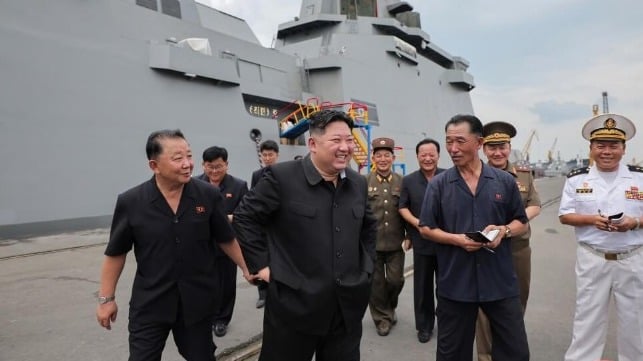Kim Jong-Un Calls for "Nuclearization" of North Korea's Navy

North Korean supreme leader Kim Jong-un has taken a personal interest in his navy's new destroyer program, attending launches and observing weapons trials. He used the occasion of his latest onboard visit to call for "rapid expansion of nuclearization" of the country's armed forces, including its naval fleet.
During a tour of first-in-class destroyer Choe Hyon on August 18, Kim called ongoing drills by U.S. and South Korean forces a threat to North Korea's security, and claimed that "the security environment around the DPRK is getting more serious day by day." He called for doubling down on Pyongyang's nuclear-centric defense strategy, including a transformation of the country's aging naval fleet to make it "high-tech and nuclear-armed."
"The Navy will become a reliable force firmly performing a part in the composition of the state nuclear forces and the realm of nuclear use in the near future," Kim said in comments paraphrased by state news agencies. Stressing speed, Kim called for the armed forces to "extremely rapidly develop the capabilities for operations of our Navy."
The new "destroyers" are frigate-sized at about 5,000 tonnes, but are heavily armed. They carry a combined 74 VLS cells of various sizes, including large cells for possible ballistic missile armament, plus angle-launch cruise missile racks and (analysts believe) a Pantsir-ME short range air defense system.
In form, they appear to be a stretched variant of Russia's Admiral Grigorovich-class frigate, according to Janes analyst Mike Plunkett. If North Korea's claims are correct, the first two hulls were built in just over a year's time, a pace unmatched by advanced shipbuilding nations. The rushed timeline has prompted questions about whether the vessels were even fitted with engines; first-in-class Choe Hyon has not been seen making way under its own power, and appears to be riding unusually high in the water.
The vessels are few in number and readily tracked, and Western analysts have questioned their survivability and deterrence value as nuclear launch platforms; but their military capabilities may be secondary to their propaganda mission, according to Khang Vu, a defense scholar at Boston College.
"Big and modern warships confer national leaders with a great sense of achievement. The North Korean chairman will soon enter his 15th year in the top job, and leaving a legacy that can rival those of his father and grandfather is highly important," Vu wrote for the Lowy Interpreter. "Turning the navy from a coastal to a blue-water force was a task neither his father nor grandfather could accomplish. He is using the launch of the destroyers – successful or not – to demonstrate his regime’s ability to innovate and to correct its mistakes."
The second hull in the series is under repair after a failed side-launch sequence, and the third hull is under construction. Nampho Shipyard's workforce has pledged to deliver the third vessel in just 14 months, according to North Korean state media.
